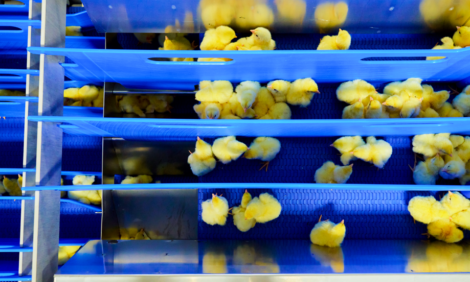



Egg Holding: Dont sweat it
By Brian D. Fairchild Extension Poultry Scientist, University of Georgia, Athens, Georgia. Published by Poultry Science - Hatching eggs are generally held in storage between 1 and 4 days prior to being transported to the hatchery. Because it may be 5 to 10 days before the eggs are incubated, embryonic development has to be suspended during the holding period between lay and incubation to ensure embryo survival.
In order to suspend embryo development the egg temperature needs to be
decreased to physiological zero which is commonly accepted to be 68 to 70°F. Research indicates
that the longer storage times require lower temperatures (Table 1.).
| Table 1: Example of holding temperatures for hatching eggs | ||
| Egg Storage Time | Holding temperature | |
| Less than 4 days | 65-69°F | |
| 4 to 7 days | 60-65°F | |
| 7 days or longer | 55-60°F | |
When eggs are transported from the farm to the hatchery, they can be exposed to a wide
range of temperatures. Ideally, the temperature would be held constant and the eggs would not be
allowed to warm up until they are ready to be incubated. When eggs are exposed to temperatures
greater than the storage temperature they can begin to sweat.
Eggs sweat because the warm air that encounters the egg contains moisture. As the air comes in contact with the egg it is cooled and the water holding capacity is reduced. Condensation then forms on the cooler eggshell surface.
Egg sweating can be detrimental to embryo survival because the condensation can facilitate the
penetration of contaminants through the shell pores. Egg sweating has been considered a potential
source of contamination of eggs from different farms when in transport or stored in the hatchery.
One way that sweating could be avoided is by holding hatching eggs at higher temperatures.
Exposure to varying temperatures is a stress on the embryo and any stresses have the potential to
reduce hatchability. As a result, all efforts should be taken to ensure that temperature remains
constant.
Recent Work
A paper published recently in the Journal of Applied Poultry Research investigated the
possibility of holding eggs at higher temperatures (Bourassa et al, 2003). Eggs (5,632) were
collected over a 4 day period and were divided into two treatments where the holding temperature
was either 66 ± 2 °F or 74 ± 2 °F. On Day 5 eggs were then driven 10 miles in an unrefridgerated
truck to simulate transport and were stored overnight at 66 °F. On Day 6 the eggs were warmed at
room temperature for 4 hours and then incubated at 99.5 °F and 55% RH.
The results of the study indicated that holding broiler hatching eggs in the farm egg cooler
for 1 to 4 days at a temperature of 74 °F was not detrimental to hatchability or incidence of embryo
or chick abnormalities (Table 2).
| Table 2: Hatchability and abnormality data for eggs held at either 74 °F or 66 °F for 1 to 4 days prior to incubation | ||||
| Holding temperature |
Percent Infertile of all eggs set |
Hatch of all eggs set |
Hatch of fertile eggs |
Embryo & Chick Abnormalities |
| 66°F | 8.6 | 82.1 | 90.1 | 38.8 |
| 74°F | 7.8 | 83.1 | 90.2 | 27.4 |
| P | 0.65 | 0.54 | 0.94 | 0.19 |
Increasing hatching egg holding temperature on the farm could reduce the temperature
fluctuations that some embryos may experience during transport. For example, if eggs were
transported in a truck with an interior temperature of 80 °F, those stored at 74 °F would
experience a 6 degree difference in temperature.
Eggs stored at 66 °F would be exposed to a 14 degree difference. When eggs are transported between 10 and 50 miles in this environment, this exposure could be significant. The smaller temperature difference would also help reduce egg sweating during transport and reduce the possibility of surface bacterial contamination.
This research is a good starting point, but as with any management decisions, care should be taken before making radical changes to any hatching egg program. It is crucial that egg coolers operate correctly and that eggs be held at a constant temperature to ensure embryo survival. These data were collected under controlled conditions and commercial facilities may perform differently and should be carefully evaluated before any large scale changes are initiated.
References
Bourassa, D. V., R. J. Buhr, and J. L. Wilson, 2003. Elevated egg holding-room temperature of 74°F (23°C) does
not depress hatchability or chick quality. J. Appl. Poult. Res. 12:1-6.
The study is published in the University of Georgia's Poultry Science - Poultry Tips for the Year 2004
Source: University of Georgia - Poultry Science - May 2004










